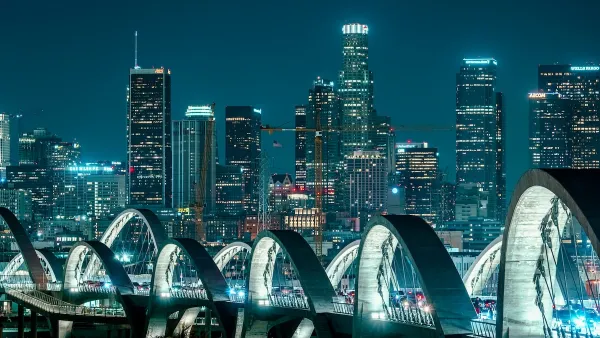A recent event organized by Good Magazine, Sheridan/Hawkes Collaborative and The Public Studio brought together about 30 civic-minded designers, planners and architects to come up with some ways to improve the urban environment of Los Angeles. It was a big question to tackle in one afternoon, with a huge array of possible solutions. The crowd was split up into five separate groups and surprisingly, each came up with a similar answer: taco trucks. OK, not taco trucks specifically, but the essence of taco trucks and what they bring to the city.
A recent event organized by Good Magazine, Sheridan/Hawkes Collaborative and The Public Studio brought together about 30 civic-minded designers, planners and architects to come up with some ways to improve the urban environment of Los Angeles. It was a big question to tackle in one afternoon, with a huge array of possible solutions. The crowd was split up into five separate groups and surprisingly, each came up with a similar answer: taco trucks. OK, not taco trucks specifically, but the essence of taco trucks and what they bring to the city.
They're informal, they're impermanent-yet-reliable, they're small local business, and they activate the street. Overall they represent a unique blend of private business and public space that puts dollars in the local economy and eyes on the streets.

A bunch of people trying to make L.A. better. (Photo by Eric Drachman)
That's how taco trucks came to be a central element of the ideas in each of the plans devised by these five groups of civic-minded people to improve the city of Los Angeles. The group into which I added my meager two cents used the idea of the taco truck as a launching pad for a broader vision of established 'flexible' zones that could harbor a variety of temporary uses, both public and private. As we quickly bounced ideas off of each other, one revelation stuck out to me and that was the absence of that unique blend of private and public in most development projects. Sure, there are public plazas in front of skyscrapers and outdoor seating at cafes, but not too many instances where the public-ness doesn't seem tacked on or the private-ness doesn't seem like an invasion. The lines between public and private are appropriately clear, but do their physical locations have to be as distinctly separated?
Think of a typical mixed use project, a building with a few retail shops on the street level and some apartments on the floor or two above. The proximity creates an implicit connection between resident and local (or at least nearby) merchants, forms an economic bond and activates the street to make a livelier, more vibrant neighborhood. So you have private homes and private businesses and you throw in some shoppers and you've got a mixed-use, mixed-activity space. Granted, that arrangement might not be right for everyone or every place, but the resulting benefits to streetlife are pretty clear, I think.
But what if there were space within that project for public meetings, or a rentable kiosk space in front of the building where fruit peddlers could stand, or an open space that holds vendors during the day and outdoor events at night? Mixed use, it sometimes seems, just isn't mixed enough. Maybe mixed use needs to get mixier. Should publicly available space be zoned into new projects? Maybe, but that prospect opens a lot of questions about what "public" really means. Should temporary spaces be able to house multiple types of uses depending on the time of day and season? It might work, with the right combination of entrepreneurship, market forces and administration. Maybe it's easier said than done, but I think it's worth considering. The mixed use projects we've seen in recent years are an improvement from the single-use zoning chokehold of the past, but simply limiting our developments to a mix of two or three uses might not be doing enough to create more active and attractive places in our cities.

Planetizen Federal Action Tracker
A weekly monitor of how Trump’s orders and actions are impacting planners and planning in America.

Map: Where Senate Republicans Want to Sell Your Public Lands
For public land advocates, the Senate Republicans’ proposal to sell millions of acres of public land in the West is “the biggest fight of their careers.”

Restaurant Patios Were a Pandemic Win — Why Were They so Hard to Keep?
Social distancing requirements and changes in travel patterns prompted cities to pilot new uses for street and sidewalk space. Then it got complicated.

Albuquerque Route 66 Motels Become Affordable Housing
A $4 million city fund is incentivizing developers to breathe new life into derelict midcentury motels.

DC Area County Eliminates Bus Fares
Montgomery County joins a growing trend of making transit free.

Platform Pilsner: Vancouver Transit Agency Releases... a Beer?
TransLink will receive a portion of every sale of the four-pack.
Urban Design for Planners 1: Software Tools
This six-course series explores essential urban design concepts using open source software and equips planners with the tools they need to participate fully in the urban design process.
Planning for Universal Design
Learn the tools for implementing Universal Design in planning regulations.
Heyer Gruel & Associates PA
JM Goldson LLC
Custer County Colorado
City of Camden Redevelopment Agency
City of Astoria
Transportation Research & Education Center (TREC) at Portland State University
Camden Redevelopment Agency
City of Claremont
Municipality of Princeton (NJ)




























